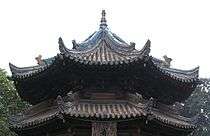Utsul
| Total population | |
|---|---|
| (at least 6,000[2]) | |
| Regions with significant populations | |
|
| |
| Languages | |
|
Tsat (native) Mandarin, Hainanese | |
| Religion | |
| Islam | |
| Related ethnic groups | |
| Chams, Malay people, other Austronesian peoples |
| Part of a series on:
Islam in China | ||||||
|---|---|---|---|---|---|---|
 | ||||||
|
||||||
|
| ||||||
The Utsuls ([hu˩ t͡saːn˧˨]; traditional Chinese: 回輝人; simplified Chinese: 回辉人; pinyin: Huíhuī rén) or (Chinese: 海南回族; pinyin: Hǎinán huízú) are a Chamic-speaking ethnic group which lives on the island of Hainan, China, and are considered one of the People's Republic of China's undistinguished ethnic groups. They are found on the southernmost tip of Hainan near the city of Sanya.
History
However, they are thought to be descendants of Cham refugees who fled their homeland of Champa in what is now modern southern Vietnam to escape from Vietnamese invasion.[3] After the Vietnamese completed the conquest of Cham, sacking Vijaya, the capital of Champa, a Cham Prince and some 1,000 Cham moved to Hainan, where the Ming dynasty allowed them to set up an exile kingdom.[4] Several Chinese accounts record Cham arriving on Hainan even earlier, from 986, when the Cham capital fell in 982, several Cham fled to Hainan during the Song dynasty.[5] After the 982 fall of the capital Indrapura to Vietnam, some Cham fled to Guangzhou in addition to Hainan.[6]
While most of the Chams who fled Champa went to neighbouring Cambodia, a small business class fled northwards. How they came to acquire the name Utsul is unknown.
Identity
Although they are culturally distinct from other Hui people, the Chinese government places them as members of Hui nationality because of their Islam religion. However, from reports by Hans Stübel, the German ethnographer who made contact with them in the 1930s, their language is completely unrelated to any other language spoken in mainland China.[7] About 3,500 of them are speakers of the Tsat language, which is one of the few Malayo-Polynesian languages that are tonal. Whereas other Hui people are Muslims who do not have a mother tongue or traditional ethnic language distinct from the Sinitic dialects, the Utsuls do have their own language, which is regarded as separate and distinct from Sinitic dialects. As a result, their classification as Hui people is controversial.
Genetics
Dongna Li and Chuan-Chao Wang have typed paternal Y chromosome and maternal mitochondrial DNA markers in 102 Utsat people to gain a better understanding of the genetic history of this population. High frequencies of the Y chromosome haplogroup O1a*-M119 and mtDNA lineages D4, F2a, F1b, F1a1, B5a, M8a, M*, D5, and B4a exhibit a pattern similar to that seen in neighboring indigenous populations. Cluster analyses (principal component analyses and networks) of the Utsat, Cham, and other ethnic groups in East Asia indicate that the Utsat are much closer to the Hainan indigenous ethnic groups than to the Cham and other mainland southeast Asian populations. These findings suggest that the origins of the Utsat likely involved massive assimilation of indigenous ethnic groups. During the assimilation process, the language of Utsat has been structurally changed to a tonal language; however, their Islamic beliefs may have helped to keep their culture and self-identification.[8]
Family names
Some common Utsul family names include Chen, Ha, Hai, Jiang, Li, Liu and Pu.[9]
See also
References
- ↑ Alternative names: Utsat, Utset, Huihui, Hui, Hainan Cham
- ↑ Gladney, Dru C., ed. (1998). Making Majorities: Constituting the Nation in Japan, Korea, China, Malaysia, Fiji, Turkey, and the United States. Stanford University Press. p. 122. ISBN 9780804730488.
- ↑ James Stuart Olson (1998). An ethnohistorical dictionary of China. Greenwood Publishing Group. p. 41. ISBN 0-313-28853-4. Retrieved 2010-11-28.
- ↑ Nhung Tuyet Tran (2006). Vịêt Nam: borderless histories. Univ of Wisconsin Press. p. 104. ISBN 0-299-21774-4. Retrieved 2010-11-28.
- ↑ Anthony Grant, Paul Sidwell, Australian National University. Pacific Linguistics (2005). Chamic and beyond: studies in mainland Austronesian languages. Pacific Linguistics, Research School of Pacific and Asian Studies, Australian National University. p. 247. ISBN 0-85883-561-4. Retrieved 2010-11-28.
- ↑ Leonard Y. Andaya (2008). Leaves of the same tree: trade and ethnicity in the Straits of Melaka. University of Hawaii Press. p. 45. ISBN 0-8248-3189-6. Retrieved 2010-11-28.
- ↑ S. Robert Ramsey (1987). The Languages of China. Princeton University Press. p. 168. ISBN 0-691-06694-9. Retrieved 2013-04-20.
- ↑ Li DN*, Wang CC*, Yang K, Qin ZD, Lu Y, Lin XJ, Li H, the Genographic Consortium. Substitution of Hainan indigenous genetic lineage in the Utsat people, exiles of the Champa kingdom. J Syst Evol. 2013, 51(3):287–294.
- ↑ Graham Thurgood; Ela Thurgood; Li Fengxiang (2014). A Grammatical Sketch of Hainan Cham: History, Contact, and Phonology (reprint ed.). Walter de Gruyter GmbH & Co KG. p. 12. ISBN 9781614516040.
